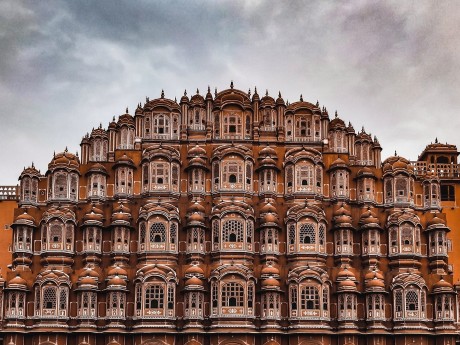India: New Delhi, Agra, Jaipur, Jodhpur
Embark on an unforgettable journey through India's vibrant cities: New Delhi, Agra, Jaipur, and Jodhpur. Begin in New Delhi, where ancient monuments like the Red Fort and Qutub Minar stand alongside modern marvels like India Gate and the Lotus Temple. Next, visit Agra and marvel at the iconic Taj Mahal and majestic Agra Fort. In Jaipur, explore the grandeur of the Amber Fort, the City Palace, and the Hawa Mahal, and dive into vibrant bazaars.
Read more
Embark on an unforgettable journey through India's vibrant cities: New Delhi, Agra, Jaipur, and Jodhpur. Begin in New Delhi, where ancient monuments like the Red Fort and Qutub Minar stand alongside modern marvels like India Gate and the Lotus Temple. Next, visit Agra and marvel at the iconic Taj Mahal and majestic Agra Fort. In Jaipur, explore the grandeur of the Amber Fort, the City Palace, and the Hawa Mahal, and dive into vibrant bazaars. Finally, head to Jodhpur to see the imposing Mehrangarh Fort and the stunning Umaid Bhawan Palace. This trip offers a perfect blend of historical wonders, architectural splendor, and cultural richness, making it truly unforgettable. Waterviews strives to offer accommodation options within walking distance of water and/or in an area of touristic interest. Our prices include taxes (but excludes local tourist taxes). Customize your trip to your personal preferences with optional activities (hit the “Add Activities’’) or change hotels, etc. Contact us for customization at no extra cost at: Service@waterviewstravel.com
Destinations
- Delhi
- Agra
- Jaipur
- Jodhpur
Itinerary
Delhi
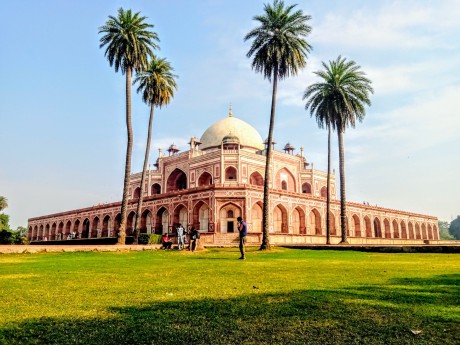
Delhi is India’s modern capital, and it is here that you can witness the merging of old and new. The city’s vibrant, colourful and sometimes chaotic streets offer an insight into modern day India as well as into its rich history, with evocative street bazaars, ancient monuments and colonial-era buildings on every corner. Made up of seven ancient cities, Delhi’s past spans centuries, and as a result the city is home to a plethora of temples, tombs and mosques that will transport you back in time.
Read more
Delhi is India’s modern capital, and it is here that you can witness the merging of old and new. The city’s vibrant, colourful and sometimes chaotic streets offer an insight into modern day India as well as into its rich history, with evocative street bazaars, ancient monuments and colonial-era buildings on every corner. Made up of seven ancient cities, Delhi’s past spans centuries, and as a result the city is home to a plethora of temples, tombs and mosques that will transport you back in time.
Additional Information
Travellers with little experience of visiting developing megacities will find Delhi to be chaotic, crowded and for much of the year, polluted. During the late spring and early summer months, the city is scorchingly hot. Dig a little deeper however and you will get a glimpse of order beneath the chaos as well as India's traditional and modern cultural richness flourishing side by side. First-time visitors feeling the culture shock are recommended to not compound that by visiting during adverse weather conditions, and get a decent hotel room so you can stay in comfort between your sightseeing trips.
History
With evidence of continuous settlement dating back to the 6th century BC, Delhi is one of the oldest inhabited cities in the world. Thought to have been built and destroyed eleven times, evidence of at least eight distinct settlements can still be seen in Delhi. The most well-preserved historic sites are from the periods of Muslim and British rule, between 1193 and the 1947.
The legendary city of Indraprastha from the epic Mahabharata is said to have been situated where Delhi now lies, but no remains of it have been found.
From the 10th to 14th century, the city was centred in what is now South Delhi: - Built in the 9th-10th century on what is now the far southern outskirts of Delhi. A large water reservoir can be seen, well preserved.(or Rai Pithora) – Founded in perhaps the 11th century as a city named "Lalkot" under Hindu rule, in the current Mehrauli area. In around 1180, Hindu ruler Prithviraj Chauhan expanded this city and renamed it Qila Rai Pithora. Some of the ruins of the fort ramparts from this period are still visible around Qutab Minar and Mehrauli. – Shortly afterwards, in 1192, Muslim leader Muhammad Ghori defeated Prithviraj Chauhan in battle. Ghori left his slave Qutub-ud-din Aibak as his viceroy, who in turn captured Delhi the subsequent year. After Ghori's death in 1206, Qutub-ud-din proclaimed himself the ruler of Delhi and founded what is known as the Slave Dynasty of the Delhi Sultanate. Qutub-ud-din contributed significantly in terms of architecture by building Mehrauli. His most prominent contribution is the starting of Qutub Minar (which was finally completed in 1220). The tombs and other buildings near the Qutub Minar also date to this period. - The Slave Dynasty was followed by the Khilji (or Khalji) dynasty. In 1303 they established Siri, first as a military camp to protect against possible Mongol invasion, and later as a fortified city. Nowadays Hauz Khas complex (north of Mehrauli) contains ruins of Siri Fort, a madrassa, and other buildings from the period. - After the Khiljis there was chaos until Ghiyasuddin Tughlaq (a Turk governor) invaded Delhi in the 1320s, started the Tughlaq dynasty, and founded a new capital Tughlakabad, in South East Delhi. His son Muhammad Bin Tughlaq created another city called Jahapanah in the area between Siri and Qila Rai Pithora, uniting them into one city. Tughlakabad continued, however, to be the main capital city.
Starting in the 14th century, new areas were built further north, near the current city center:(or Kotla Firoze Shah) - built by Muhammad Bin Tughlaq's son, Firoze, in 1354. There still are some ruins which are visible around the Feroz Shah cricket stadium in Central Delhi, near the river. The city was an enclosed a large area, and contained many palaces, mosques, pillared halls, and a multi-floored water reservoir. Firoze also erected a 1500-year-old Ashokan Pillar (previously erected in Meerut by Samrat Ashok) on top of the palace. Firoze was buried inside a lofty tomb in Hauz Khas. After his death, the sultanate became unstable and weak, and Delhi was conquered and sacked by Tamerlane. The Sayyid and Lodhi dynasties who ruled Delhi after the Tughlaqs did less building, and the only relevant architecture visible from this period are the tombs at Lodhi Gardens. The last of the Lodhis was defeated by Babur, who then proceeded to establish the Mughal Empire in 1526. - In 1533, Babur's son Humayun built the new city of Dinpanah, near the river south of Firozabad. In 1540 Humayun was defeated by Sher Shah Suri and forced to withdraw from Delhi. Sher Shah Suri established the new city Shergarh on the ruins of Dinpanah. Shergarh is what you see at Purana Qila today, near the Delhi zoo. Humayun later reconquered Delhi and returned to power. He then completed the construction and proceeded to rule from Shergarh. - the following emperors moved away from Delhi and made Agra their capital. Shahjahan (Humayun's great-grandson) returned to Delhi and established Shahjahanabad (modern Old Delhi), including the Jama Masjid and the Red Fort. Much of the city wall, and three of its six gates, still exist today. - New Delhi was established in 1911 after the British decided to move India's capital from Kolkata. It is a planned city, designed by architect Sir Edwin Lutyens.
Demographics
Not all descendants of the builders of Delhi's many Muslim monuments live in Delhi. Many of them migrated to Pakistan during the Partition, with the community in Old Delhi that is keeping old courtly traditions alive smaller than it once was. The city is rich in monuments, including 174 ASI protected monuments.
The population of Delhi is a heterogeneous mix of people originally belonging to different parts of North India and beyond. Among the prominent North Indian communities are the Punjabis. Delhi also has a prominent South Indian Community, primarily in neighborhoods like Karol Bagh, RK Puram, Mayur Vihar and Munirka. A Bengali settlement, the Chittaranjan Park in south Delhi, is the Mini Calcutta of Delhi. Quality education also draws students from different states, making up one of the most diverse student populations in the country.
Orientation
Like the rest of the Gangetic Plains, Delhi is as flat as a pancake. The only geographical features of any significance are the river Yamuna, which flows down the eastern side of the city, and the Aravalli Hills which form a wide but low arc across the west. On the west bank is the crowded and congested Old (Central) Delhi and, to the southwest, the broad, tree-lined avenues of New Delhi, built by the British to rule their empire. The rest is an endless low-rise sprawl of suburbia and slums, with southern Delhi generally wealthier.
© Sourced from Wikivoyage
Agra
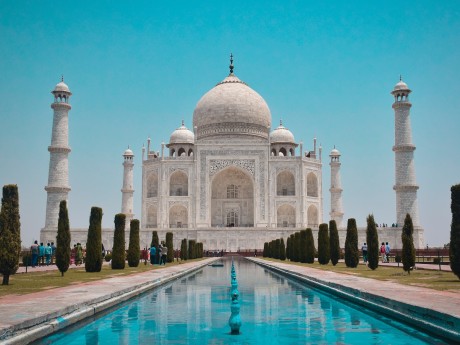
Once the capital of a grand Mughal empire and a leading centre for art, commerce and culture, Agra boasts a fascinating history that is today reflected in its impressive architecture. Home to the country’s most iconic landmark, the Taj Mahal, Agra draws in hordes of visitors from India and afar who come to marvel at the magical monument. Although the Taj Mahal is the star attraction, there are some other worthwhile stops here too like the Agra Fort, a number of tombs and mausoleums and an array of bustling bazaars.
Read more
Once the capital of a grand Mughal empire and a leading centre for art, commerce and culture, Agra boasts a fascinating history that is today reflected in its impressive architecture. Home to the country’s most iconic landmark, the Taj Mahal, Agra draws in hordes of visitors from India and afar who come to marvel at the magical monument. Although the Taj Mahal is the star attraction, there are some other worthwhile stops here too like the Agra Fort, a number of tombs and mausoleums and an array of bustling bazaars.
Additional Information
Agra, in so many words, is the home of the Taj Mahal, the magnificent monument of love. It was built by Shah Jehan in memory of his beloved queen. Construction of the world-famous landmark began in 1631 and believed to have taken 22 years to complete with more than 20,000 craftsmen working around the clock. The design and construction of the monument is generally credited to legendary architect Ustad Ahamad Lahori who, as the story goes, lost his hands and was blinded by order of Shah Jehan so that he would never duplicate such a structure.
What makes the Taj Mahal so unique is its perfect proportions, distinct feminity, medium of construction and ornamentation. Its marble exterior reflects rose and golden tints at sunrise and sunset, while dazzling white during the day. It is impossible to visualize the Taj Mahal in any surrounding other than its paradoxical garden. Paradise, in Islam, is visualized as a lush garden where running streams flow, and, when the Mughals brought this concept to India they elevated it to heights of incomparable artistry. The Taj Mahal is one of the great accomplishments of that dynasty.
Jaipur
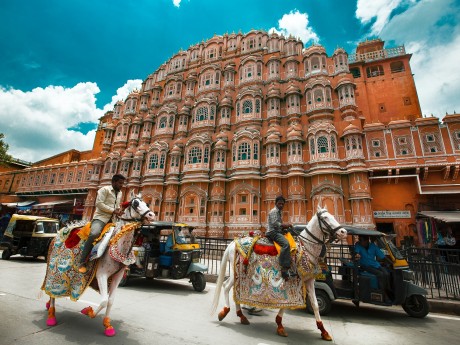
Also known as the “Pink City”, Jaipur is the capital of the colourful state of Rajasthan. A kaleidoscope of colour and sound, the bustling streets of the city’s old town are teeming with rickshaws, tuk-tuks, motorbikes and camels, and are home to a collection of historic, pastel-coloured buildings that reflect its majestic heritage. Jaipur is also a centre for shopping, and is the perfect place to find artisan textiles, jewellery and clothing.
Read more
Also known as the “Pink City”, Jaipur is the capital of the colourful state of Rajasthan. A kaleidoscope of colour and sound, the bustling streets of the city’s old town are teeming with rickshaws, tuk-tuks, motorbikes and camels, and are home to a collection of historic, pastel-coloured buildings that reflect its majestic heritage. Jaipur is also a centre for shopping, and is the perfect place to find artisan textiles, jewellery and clothing.
Additional Information
Take a trip through the old part of town where you will experience a vibrant street life that you thought only existed in magazines and movies, and watch the streets explode in many different colors and sounds during numerous festivals and events. The legacies of the Rajput dynasty are on full display here in monuments and structures that still retain much of their former glory, and the city itself is one of the major centers in India for textiles, jewellery and many other items.
This city is one of the three "Golden Triangle" cities in India - the others being Agra and Delhi - and continues to be a very popular destination for tourists and a unique jewel in southeast Asia.
Jodhpur
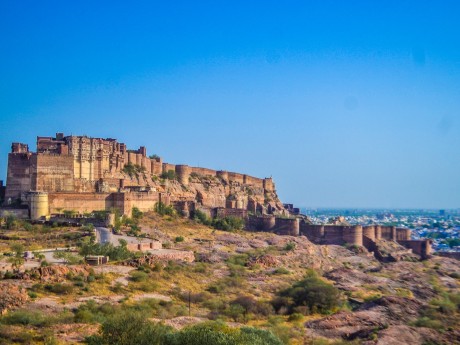
Overlooked by the majestic Mehrangarh Fort, the ‘Blue City’ of Jodhpur is one of India’s most evocative. Inside the city walls, a maze of winding and atmospheric streets are lined with colourful houses, street bazaars and spice markets where you can shop for unique decorations, clothing and textiles. Be sure to pay a visit to the Jodhpur's collection of impressive palaces, temples and gardens to soak up its rich history.
Read more
Overlooked by the majestic Mehrangarh Fort, the ‘Blue City’ of Jodhpur is one of India’s most evocative. Inside the city walls, a maze of winding and atmospheric streets are lined with colourful houses, street bazaars and spice markets where you can shop for unique decorations, clothing and textiles. Be sure to pay a visit to the Jodhpur's collection of impressive palaces, temples and gardens to soak up its rich history.
Additional Information
Founded in 1459 and the oldest of Rajputana's great cities, Jodha's Jodhpur preceded Bika's Bikaner by thirty years, Udai Singh's Udaipur by more than a hundred, and Jai Singh's Jaipur by nearly three centuries. Dominated by one of India's mightiest fortresses in the Mehrangarh Fort, the capital of the warrior Rathore Rajput clan has played hostess to kings and emperors and tsars; to humble saints and celebrated soldiers; to many a distinguished statesman of our times and of times gone by.
While not the wealthiest city in India, Jodhpur is perhaps the country's most charming and a gateway to the Great Thar Desert, and stands alone as the cultural and spiritual capital of the Land of Kings.




